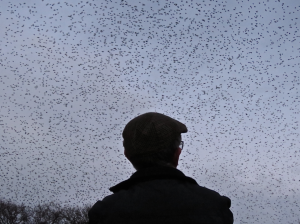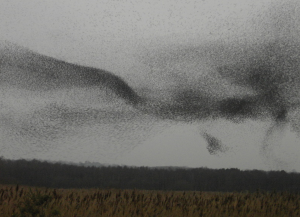Over the last few weeks, people have been getting all of a flutter due to the mesmerising Starling murmuration at Shell Bay, Studland. Since late December the flock has been growing as have the crowds of onlookers all waiting in anticipation for one of natures best and most spectacular events….but what is a Starling murmuration?
A murmuration is a large gathering of Starlings that forms at dusk before they all drop down into reedbeds, urban tree lines or dense thick hedgerows for the long cold winter nights. The ‘murmur’ is said to relate to the noise the birds wings make as they pass at close quarters, as for up to half an hour prior to them entering the roost they perform an incredible show of twisting and turning acrobatics, never once colliding with one another and all in perfect sync. The performance its self is enough to satisfy most peoples nature fix but the inquisitive amongst you will be asking…..why do they do this? Well, the murmurations in fact has several main functions. Firstly, you’ll only ever see these murmurations during the winter as Starlings from central and eastern Europe and even Russia join our local birds as they escape the cold that grips those areas from November through to February. You may have seen in the news recently that in central and eastern Europe at present temperatures have plummeted to minus 20 in some places, which would explain the increase in Starlings we’ve seen here in Poole Harbour. As you can imagine, sitting in a reedbed all night in the middle of winter is going to be pretty chilly so one of the main functions of the murmuration is to build body heat in each individual bird, which will collectively with all other birds in the roost act as one giant heater amongst the roost. That’s why it’s important to have so many birds roosting together and why the murmurations can get so big. Secondly, the murmuration is a social event and as the Starlings fly around they’re vying for position with the adult males making sure they enter the roost first as it’s the warmest safest place to be thorough out the night, followed by the females and then 1st winter (youngest) birds. Thirdly, murmurating will obviously attract some unwanted attention in the form of Sparrowhawk, Peregrine and Merlin, so the bigger and more complex the flock looks the more difficult it is for a predator to penetrate the flock to take a single bird.

Starling flock – Shell Bay Studland – Jan 2017 – Paul Morton

The roost at Studland is by no means new with Starlings roosting there pretty much every winter since the late sixties. However the size of the flock can vary greatly depending on conditions in mainland Europe with just a couple of hundred which will go unnoticed to most people, to a max roost count of 32,000 in the winter of 1994/95. The current estimate of this winters flock is approx 15,000 birds and the main bulk of the flock has been tracked arriving in all the way from Dorchester!

Starling flock – Shell Bay Studland – Feb 2007 – Phyl England
Really nice spring record of a female Hawfinch above the RSPB Arne Car Park this morning. It’s a…
Find out moreThe sunny weather made perfect conditions for our Spring Safari Cruise this morning and also brought out plenty…
Find out more© 2025 Birds of Poole Harbour Registered Charity No. 1152615